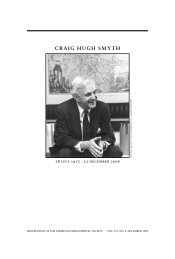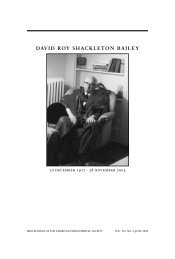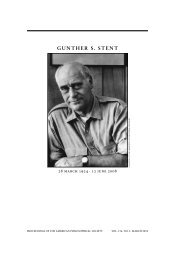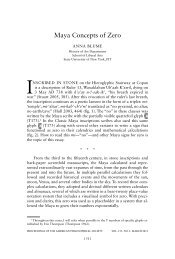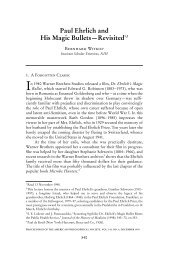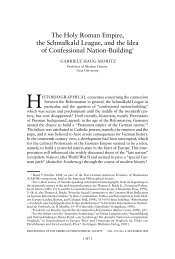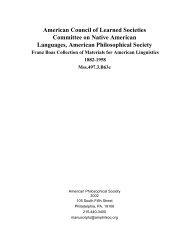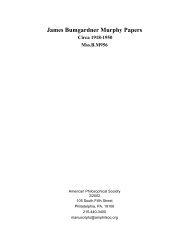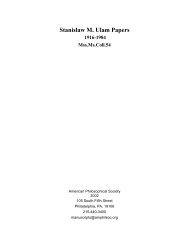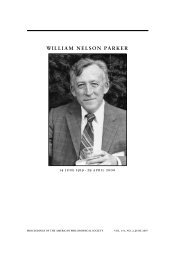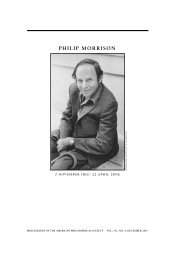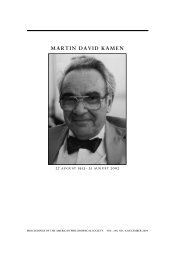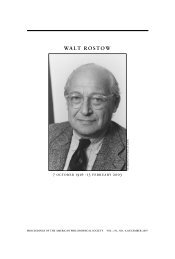Performing the Fandango in Mozart's Le nozze di Figaro1
Performing the Fandango in Mozart's Le nozze di Figaro1
Performing the Fandango in Mozart's Le nozze di Figaro1
You also want an ePaper? Increase the reach of your titles
YUMPU automatically turns print PDFs into web optimized ePapers that Google loves.
<strong>the</strong> fandango <strong>in</strong> mozart’s LE NOZZE DI FIGARO 169<br />
Dance is completely unknown here. I’m speak<strong>in</strong>g of fi gured dance, for<br />
I cannot <strong>di</strong>gnify with that name <strong>the</strong> grotesque and often <strong>in</strong>decent<br />
movements of <strong>the</strong> grenad<strong>in</strong>e and Moresque dances that so delight <strong>the</strong>se<br />
people. The most highly esteemed dance here is called <strong>the</strong> fandango,<br />
<strong>the</strong> music of which is extremely vivacious, and <strong>in</strong> which all pleasure<br />
consists of a few steps or lascivious body positions, [ . . . ] portray<strong>in</strong>g<br />
well enough [ . . . ] so that I, who am not <strong>the</strong> most pru<strong>di</strong>sh of men,<br />
blushed to <strong>the</strong> roots of my hair. A young Spanish woman, without<br />
rais<strong>in</strong>g her eyes and with <strong>the</strong> most modest countenance, gets up to<br />
start mov<strong>in</strong>g her body <strong>in</strong> front of an impudent vaulter; she beg<strong>in</strong>s by<br />
stretch<strong>in</strong>g her arms and snapp<strong>in</strong>g her fi ngers; which she cont<strong>in</strong>ues to<br />
do throughout <strong>the</strong> entire fandango to mark <strong>the</strong> beat; <strong>the</strong> man turns her<br />
around, moves away, comes back with violent movements, to which<br />
she responds with similar gestures, only a little more gently, and always<br />
<strong>the</strong> snapp<strong>in</strong>g of <strong>the</strong> fi ngers, which seems to say: what do I care,<br />
go on as much as you can, I will not be <strong>the</strong> fi rst to tire.<br />
In place of <strong>the</strong> steps and fi gures characteristic of French court dances,<br />
<strong>the</strong> fandango featured girat<strong>in</strong>g hips and suggestive body movements.<br />
Giacomo Casanova, too, has left descriptions of <strong>the</strong> dance <strong>in</strong> two separate<br />
passages. “What a dance! It burns, it <strong>in</strong>fl ames, it carries away. Never<strong>the</strong>less,<br />
people tried to assure me that <strong>the</strong> majority of Spanish men<br />
and women mean no harm by it. I pretended to believe <strong>the</strong>m.” 7 It was<br />
not just <strong>the</strong> movements, <strong>the</strong>n, but also <strong>the</strong> ethos of <strong>the</strong> dance that made<br />
it culturally alien to <strong>the</strong> rest of Europe. Casanova provides greater detail<br />
<strong>in</strong> <strong>the</strong> second passage. 8<br />
The great spectacle which enchanted me came toward <strong>the</strong> end of <strong>the</strong><br />
ball, when to <strong>the</strong> music of <strong>the</strong> orchestra, after general applause, a<br />
dance for couples began than which I had never seen anyth<strong>in</strong>g wilder<br />
or more <strong>in</strong>terest<strong>in</strong>g. It was <strong>the</strong> fandango, of which I thought I had an<br />
accurate notion, but I was very much mistaken. I had seen it danced<br />
only <strong>in</strong> Italy and France on <strong>the</strong> stage, where <strong>the</strong> dancers <strong>di</strong>d not perform<br />
one [any] of <strong>the</strong> national gestures which make <strong>the</strong> dance truly<br />
seductive. I cannot describe it. Each couple danced face to face, never<br />
tak<strong>in</strong>g more than three steps, strik<strong>in</strong>g <strong>the</strong> castanets, which are held <strong>in</strong><br />
<strong>the</strong> fi ngers, and accompany<strong>in</strong>g <strong>the</strong> music with attitudes than which<br />
noth<strong>in</strong>g more lascivious could possibly be seen. Those of <strong>the</strong> man<br />
visibly <strong>in</strong><strong>di</strong>cated love crowned with success, those of <strong>the</strong> woman<br />
consent, ravishment, <strong>the</strong> ecstasy of pleasure. It seemed to me that no<br />
woman could refuse anyth<strong>in</strong>g to a man with whom she had danced<br />
<strong>the</strong> fandango.<br />
7 Giacomo Casanova, History of my Life, vol. 11, chap. 1, trans. Willard R. Trask, 12 vols.<br />
<strong>in</strong> 6 (New York: Harcourt Brace Jovanovich, 1966–71), 6:11.<br />
8 Vol. 10, chap. 12; Trask, 5:321.



